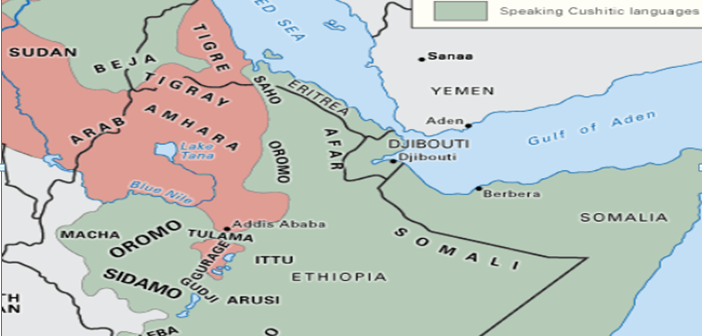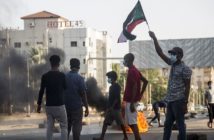The post-1990s Ethiopia presents relatively different cultural, religious, economic, and political configurations. Probably one of the most important developments peculiar to the EPRDF (The Ethiopian People’s Revolutionary Democratic Front) regime is its contested experiment with ethnic-based federalism in the country[1]. Through implementing this (re)arrangement, the existing regime, particularly the TPLF (The Tigrayan People’s Liberation Front) hoped to liberate, firstly, itself (initially the people of Tigray), and secondly, other peoples whom it considered “needed” liberation from the longstanding cultural, economic, and political hegemony of the people of Amhara and Orthodox Christianity[2]. Yet, except for its manifest and often symbolic gestures, and thus, only scratching the surface of the supposed problem, it did not necessarily dig deep enough to help resolve the historically sustained cultural, economic, and political grievances simmering beneath the existing socioeconomic and political structures in the country[3].
Although federalism of some sort is considered an inescapable way out, the important question that remains looming is whether it can adequately redress the multifaceted and multilayered problems and challenges threatening Ethiopia as a state and country[4]. In practice, however, the post-Meles Zenawi Ethiopia showcases the kind of latent and manifest problems emanating from the ethnic-based federalism experiment. Approximately, in the last seven years, Ethiopia saw a wave of massive and sustained social unrests and resentment. Beginning from the protracted Muslims’ protests for religious freedom and equality[5]; the Oromo nationwide resentment against inequality and unjust policies[6]; and to the currently all-inclusive anti-government (and especially anti-TPLF) anger and protest almost throughout Ethiopia except the Tigray region from where TPLF proudly asserts to have hailed-are all, among other things, directly relevant circumstantial and anecdotal evidence[7].
Between the last twenty years and the centuries before, there is indeed a great deal of difference characterizing Ethiopia and its peoples. Before the late twentieth century, the Abyssinian Empire mainly composed of the Tigray and Amhara peoples and Christianity as a religion had dominated the religious, cultural, economic, and political landscapes of the country. This was accompanied by centuries of ceaseless “expansions” southward and eastward which is later to make up the present day Ethiopia[8]. Due to this, one specialist of the Horn of Africa called the Empire an internal colonizer and imperialist[9]. This way, the making of today’s Ethiopia in the late nineteenth and early twentieth centuries did not succeed without inflicting pains and damages. In yet other words, it was not accomplished without causing frictions underpinning religious, cultural, and political sensibilities. Moving forward in time, many of the demonstrations, resentments, and popular apprising currently shaking the ruling EPRDF regime in Ethiopia draw their continuous inspirations from these contested historical legacies of the Empire in the broader Horn of Africa.
Broadly examined in the context of the Horn of Africa, the dissatisfaction with the Abyssinian Empire had been the key driver of Eritrea’s struggle for independence and recurrent frictions with Somalia. Essentially, there is no fundamental difference of opinions about the nature of Eritrea’s march for self-rule. One among others was the religious intolerance and persecution of Muslims under Abyssinian Christian rule. In fact, it was the Muslims-majority constituted Eritrean Liberation Front (ELF) that, especially in the decade between 1960 and 1970, waged armed struggle on behalf of the Eritreans, successfully threatening the then Emperor Haile Selassie[10]. The ELF also had behind Muslim sympathizers from the Arab world, such as Egypt, Iraq, and Syria[11]. However, following the first civil war with the Eritrean People’s Liberation Front (EPLF) in 1972, ELF generally lost its popularity and influence in Eritrea[12]. Yet, although not significant and visible, the friction between the two largely looms to these days. Interestingly, unlike ELF, the EPLF was largely Christians-dominated movement from which came Isaias Afwerki as its leader[13]. Can this be contested for an “abortive struggle for independence”? It seems religious-based violence and persecution[14] remains a serious cause of concern in the post-colonial and post-independence Eritrea[15]. Undeniably, in addition to the religious-based persecutions under Abyssinian Empire, Italian colonization of Eritrea, and other related factors played important roles in the making of Eritrea (and “Eritrean Nationalism”)[16].
Another important case that needs a closer appraisal is very much tied to the people of Somali, generally occupying the southeastern corner of the Horn of Africa. The Somali had vigorously fought against the Abyssinian Empire and later the Ethiopian state. One of the most formative periods that marked a defining moment in the history of Abyssinia and/ or Ethiopia was the sixteenth century catastrophic and bloody war between the Abyssinian Christian Kingdom and Muslim Sultanates under the leadership of the Somali Imam Ahmed ibn Ibrahim Al Ghazi[17]. For many “Ethiopianist” historians, this moment fundamentally altered the way how the subsequent Christian Abyssinian rulers saw Islam and Muslims in-and-around Abyssinia. They generally felt these were the eternal foe of Abyssinia in general and its orthodox Christianity, in particular. Haggai Erlich dubbed this as the “Ahmed Gragn Syndrome”[18].
Interestingly, quite contrary to the “Ethiopianist” historical literature and the attitude of almost all the post-sixteenth century Abyssinian rulers, he remains to be a hero for many Muslims in-and-around Abyssinia, especially more among the Somalis. In fact, they went so far as to erect a statue of Imam Ahmed in the capital of Somalia, Mogadishu[19]. Indeed, the statue was meant to transcend spatiotemporal barriers to the “golden” memory of Muslims in general and the Somali, in particular, in the general history of Abyssinia and the Horn of Africa. This way, this historical legacy remains deeply ingrained in the subconscious mind of the Somalis. In addition to this historical animosity, the war waged under Mohammed Siad Barre, the then president of Somalia (1969-91) against Ethiopia, which was then, ruled by the socialist president Mengistu Haile Mariam (1974-91) exacerbated the interstate relations. As of recently, the USA supported and Ethiopia’s EPRDF regime executed and constantly proven counterproductive fight[20] against terrorism in Somalia[21] and the Ogaden region of Ethiopia has been worsening the already fragile state of interstate relations[22], and thereby contributing to the accumulated grievances of the people of Somali in the Horn.
At the end, it is at least safe to extrapolate that many of the existing situations of the countries of the Horn are highly deep-rooted in the spillover effects of past and accumulated experiences. However, being frontline states, the future of today’s Ethiopia, Eritrea, and Somali is highly interactive and this will, thus, affect their conditions positively or negatively. Apart from seeking ways of reconciling with past memories of inconveniences, regional approaches that draw from economic integration and political consensus and order may possibly reduce the seemingly endless chaos, political and economic, that for decades defined the region. Compared to others, a lot could be expected from Ethiopia, for Ethiopia is essentially a downsized representative country of the Horn itself.
References
[1] https://www.files.ethz.ch/isn/105633/153_ethiopia_ethnic_federalism.pdf
[2] https://tassew.wordpress.com/2012/09/11/tplf-manifesto-1968-e-c-amharic
[3] http://muse.jhu.edu/article/399077
[4] https://www.trtworld.com/opinion/is-ethnic-federalism-really-the-biggest-problem-in-ethiopia–11421
[5] https://asq.africa.ufl.edu/miftah_2015
[6] http://www.africanews.com/2017/10/12/photos-massive-anti-govt-protest-in-ethiopia-s-oromia-state
[7] https://ethsat.com/2017/12/ethiopia-killing-university-students-reignite-nationwide-protests
[8] http://www.academicjournals.org/article/article1381821809_Yusuf%20pdf.pdf
[9] http://riftvalley.net/news/why-horn-different
[10] https://www.loc.gov/rr/frd/cs/profiles/Eritrea.pdf
[11] https://www.loc.gov/rr/frd/cs/profiles/Eritrea.pdf
[12] https://openaccess.leidenuniv.nl/bitstream/handle/1887/32998/ASC-075287668-3671-01.pdf?sequence=1
[13] https://www.loc.gov/rr/frd/cs/profiles/Eritrea.pdf
[14] http://www.eepa.eu/wcm/dmdocuments/Mekonnen.van_Reisen.ESF-LiU.pdf
[15] http://www.erigazette.org/?p=10594
[16] https://www.jstor.org/stable/161025
[17] http://www.jpanafrican.org/docs/vol10no1/10.1-16-Miftah.pdf
[18] http://www.hum.huji.ac.il/upload/_FILE_1376577901.pdf
[19] https://www.britannica.com/biography/Ahmad-Gran
[20] https://www.theguardian.com/world/2008/apr/23/usa.somalia
[21] http://erepository.uonbi.ac.ke/handle/11295/63136
[22] https://www.hrw.org/news/2008/06/12/ethiopia-army-commits-executions-torture-and-rape-ogaden


